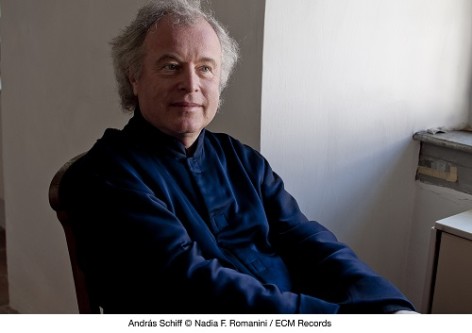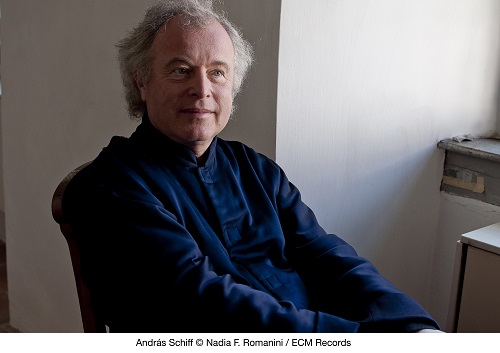 Canada Haydn, Mozart, Beethoven, Schubert: Sir András Schiff (piano), Vancouver Playhouse, 7.2.2016 and 9.2.2016. (GN)
Canada Haydn, Mozart, Beethoven, Schubert: Sir András Schiff (piano), Vancouver Playhouse, 7.2.2016 and 9.2.2016. (GN)

Mozart: Piano Sonata in B-flat major, K. 570; Piano Sonata in D major, K. 576
Haydn: Piano Sonata No. 61 in D major, Hob. XVI: 51; Piano Sonata No. 62 in E-flat Major, Hob. XVI: 52
Beethoven: Piano Sonata no. 31 in A-flat major, Op. 109; Piano Sonata No. 32 in C minor, Op. 111
Schubert: Piano Sonata in A major, D. 959; Piano Sonata in B-flat major, D. 960
I used the word ‘masterful’ when describing my reactions to the first of Sir András Schiff’s three concerts designed to probe the ‘last sonatas’ of Haydn, Mozart, Beethoven and Schubert (see review). A year later, we get the final two. One nice thing for the critic in witnessing Schiff’s patrician keyboard artistry is that it is possible to just relax and appreciate what his decades and decades of study and performance have produced in terms of wisdom and perspective. Every note of these scores has been thought over, endlessly distilled and renewed: indeed, a phenomenon which I now regard as increasingly rare. With Alfred Brendel’s retirement, there are few pianists who could offer comparably mature guides to the core repertoire between Haydn and Schubert: Murray Perahia and Richard Goode are perhaps the others.
The Sunday afternoon concert had a quiet, timeless feeling to it ̶ just the pianist and his instrument communing together, making me think of how Sviatoslav Richter played Bach in his later days (with the sole piano light on) or, as I can only imagine, how Wilhelm Kempff might have traversed Beethoven in the early 1950s. The final Tuesday night concert had a more public, demonstrative feel, and there were likely greater riches to be found in the earlier outing, even if at times the pianism was more understated. It was at this concert that Schiff played all four works without a break.
The Mozart B-flat major Sonata, K. 570 was an absolute delight: finely-proportioned, texturally astute, and consistently finding little moments of joy hiding in corners. There was a fine command of the narrative line: though the playing was often quiet, each note seemed perfectly projected and given the right weight, and the lines all seemed fresh. The Adagio just seemed to flow on and on with a sense of wonder, while the closing Allegretto had notable musical space and rhythmic cohesion. Mozart’s final sonata (K. 576) is tighter in construction and in some ways less beguiling, but Schiff accomplished a marvelous weaving together of its lines, again exhibiting pristine balance and not neglecting its moments of play and joy later on. In both sonatas, one noted two Schiff trademarks: first, his ear for balance in counterpoint; and second, his ability to find harmonic synergies that give the listener a sense of tonal integration (and familiarity) from beginning to end.
Haydn’s penultimate sonata, at a mere 6 minutes, just flew by, though it was brimful of good spirits. The big event was the commanding Sonata No. 62 in E-flat major on the final evening, and Schiff definitely approached it as a great work – almost trying to deconstruct it for us. While there were benefits in seeing the relationship between all the starts and stops in both opening and closing movements, and the many structural levels on which these operate, I did not find Schiff’s opening allegro particularly spontaneous: some of the detailing and phrasing were definitely over-conscientious. The unmistakable highlight was the Adagio, where Schiff brought out its heavenly lengths and revealed all sorts of little fragmented utterances and idiosyncrasies, often making ‘late’ Haydn have the same intrigue and stature as ‘late’ Beethoven.
Schiff has been very involved with the Beethoven sonatas over the past decade, recording the complete cycle for ECM and giving a complete Wigmore Hall series of lectures on the works. Perhaps I had some qualifications about Schiff’s Sonata No. 30 in the very first concert of the series; however, the penultimate 31st was remarkably compelling from beginning to end. It had a selfless Schubertian flow at many points, and this seemed to work almost perfectly for the opening movement: slightly understated, but always searching and fully aware of how to negotiate its many subtleties. More insistence characterized the middle Allegro but, as we moved out of the movement, suddenly the timeless spaces took over, with only the softest repeated punctuations. These were developed perfectly in parallel with the same spaces and the mighty hammer-blows later. The sense of line through the final movement was exceptional: such an intelligent treatment of the fugue, with the obvious humanity revealed at the end. What was also interesting is how sparingly Schiff used the full power of his instrument; when he did so, it really counted.
I might say the 32nd sonata on the final night was cut from the same cloth, but I am not sure that it should be. This was a very beautiful and very astute performance, often moulded, warm and flowing, with all its technical demands confidently negotiated. But in this sonata do we not look for Beethoven’s raw, fragmented utterances boldly etched, the sheer defiance, the concluding movement flirting with a world which is distilled, elliptical and almost out of control? This was not really part of Schiff’s softer, more coaxing way. Both the fugal and the famous jazzy sections of the Variations were beautifully built and projected – but they were also beautifully ‘in control’. We were not really close to the edge. The whole work seemed imbued with more life and feeling than this final testament might warrant. Nonetheless, this interpretation is quite inspiring in its own way and a fine alternative for those who might find a ‘rougher’ approach forbidding.
I had found the Schubert C minor, D. 958 of the first concert absolutely rewarding, and it was perhaps not surprising that his A major, D. 959 on Sunday afternoon was a great performance too. Every Schubert pianist has some way of conveying the unsettled, anxious quality of the composer’s last statements, but Schiff’s was quite individual. As noted in the first movement of the A major, only on a few occasions did the pianist let the composer’s long lyrical lines really settle: for all the right hand might be spinning a beautiful cantabile sequence, the left hand was always darting to and fro, summoning up frenzied, portentous ‘spirits’ trying to break the line. Were these spirits not almost ‘Lisztian’? Thus, there was invariably an abruptness to the articulation, and I recall only a few very special moments where the tender lyricism was allowed to fully flower. With the repeat included, this was a long and complex Allegro, but the continuing juxtaposition of these two sides gave it wonderful meaning and intensity.
The Andantino maintained the same concentration, actually starting at a fairly quick pace but this was broken perfectly by the powerful ‘fugal storm’, a full torrent of energy that ultimately left one limp. Then, after the release, the slowing of the tempo was judged to perfection. The Scherzo was also quite unique, conjuring up a hardly-tangible fantasy world where only innocent children play, swing on swings, and so on. This was so beautifully and tenderly conveyed by Schiff: utterly believable. And it served a strategic purpose, since the last movement could use this world as a very effective retreat from its more demonstrative happenings. The finale did come off to stunning effect: the nervous unsettled quality from the first movement always walking side-by-side with the movement’s lovely lyrical theme, momentary retreats to the child’s soft fantasy world, all put together with compelling determination as we approached the final glorious restatement of the work’s opening theme. I’ve not heard a more revealing and complex understanding of this movement.
The final B-flat Sonata, D. 960 was also a fine performance, but I don’t think it achieved quite the same intensity and concentration. The interpretation had warmth and tenderness, and the right type of lyrical beauty, but, at least in the first two movements, Schiff’s radar did not seem as strong as that of, say, Sir Clifford Curzon, Alfred Brendel, or Imogen Cooper in unearthing the subtle emotional changes or in registering structural tensions. In some parts of the Andante, the playing was just slightly generalized. The Scherzo was admirable (including some bottom thumps from the left hand that I had never noticed before), but the highlight was the finale, where the pianist managed to blend very convincingly the ease of the composer’s writing in his Impromptus with the haunting feeling of a floating, euphoric world.
I’ve summarized the many virtues of the individual performances here but admit that my overriding feeling was simply awe at just what a unique treasure this all was: the greatness of the compositions, the variety in the works and Sir András Schiff’s mastery over them. This doesn’t come along very often. Most appropriately, the concluding encore was the Aria from Bach’s Goldberg Variations.
Geoffrey Newman

BBC lectures? Do you know if these are available to view or purchase?
Sorry, I meant the Wigmore Hall Beethoven lectures, which are well known and seemingly available online from a variety of sources.